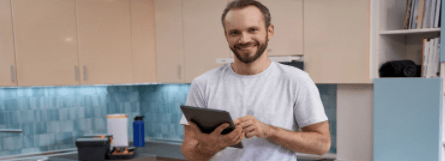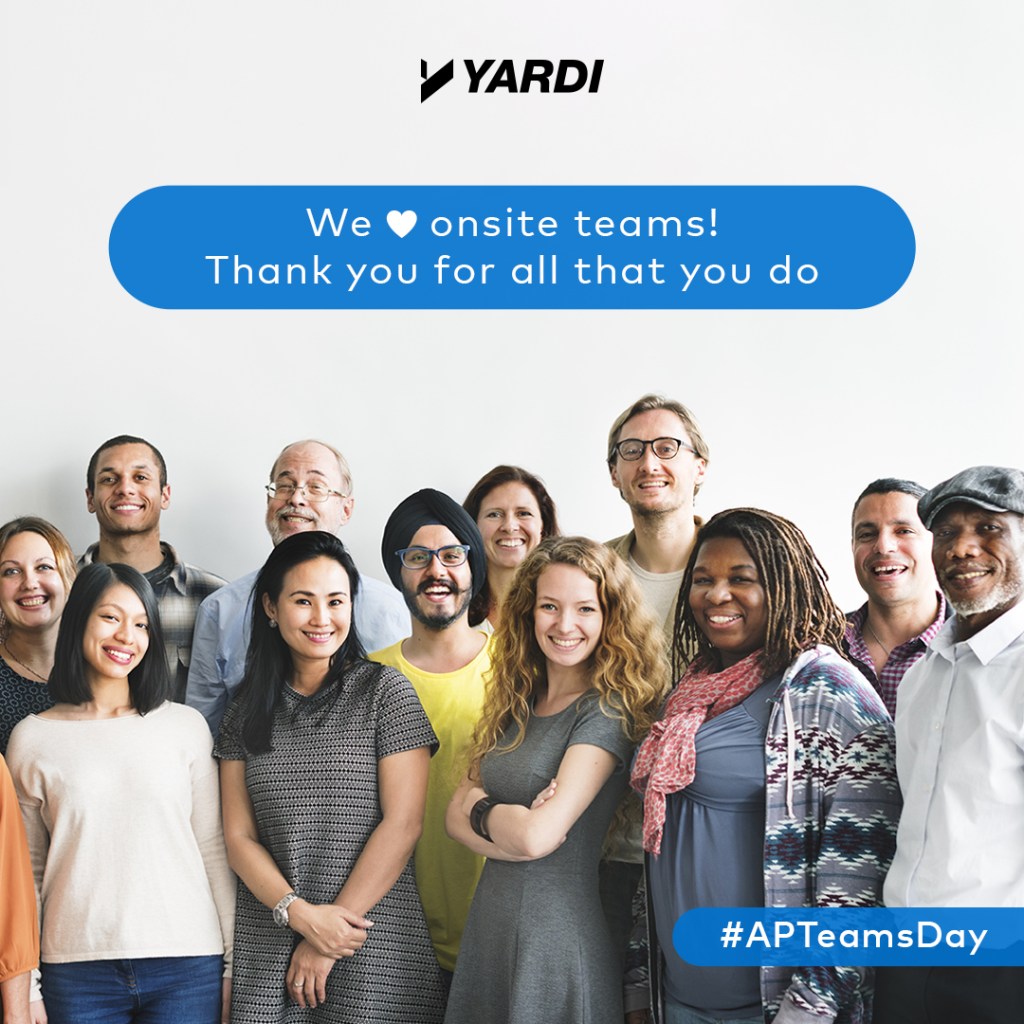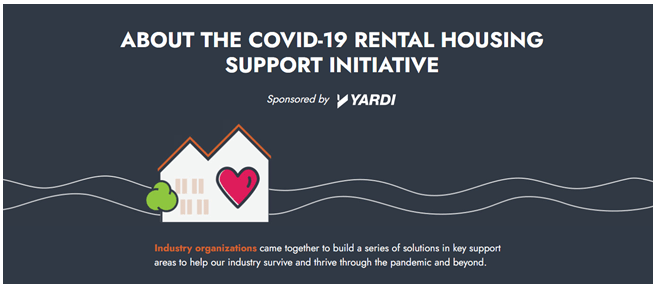Want to improve your net operating income (NOI)? Consider your turn process. Whenever a unit is unoccupied, you’re missing out on income. Vacancies during the turn process are no exception. By decreasing the time that it takes to turn a unit, you can maximize your income and support better NOI. Below are a few practical tips to help you expedite turns, save time and money. Expedite services with cloud-based, integrated property management software. Y Problem: You’re currently managing turns on paper, spreadsheets or client-server applications. This means a lot of manual data entry, printing, slower communication and wasted time. All of those delays result in a longer timespan to complete work orders and get new residents into units. Solution: Reduced turn time starts in the leasing office. Gain full visibility into your site with cloud-based property management software that integrates with your maintenance and procurement solutions. This powerful combination automates processes from the second that your resident gives notice. Automation and integration can help you reduce vacancy days and increase net rental income. Help techs save time and money with mobile-ready software. Problem: Your techs waste a lot of time trekking back and forth between the leasing office, stockroom and units. Their progress on work orders is a mystery throughout the day, and it’s difficult to determine where you can find greater efficiencies during turns. Solution: Fewer trips to the leasing office, stockroom and store mean more time saved. A mobile maintenance app empowers techs to connect to the cloud, log work order progress, completion and images while on the go. Transparency into the turn process allows you to identify where additional training or greater efficiencies may be helpful. A customized online catalog takes the errors and guesswork out of procurement. Problem: Maintenance techs rely on outdated techniques to log the products needed to complete work orders. As a result, they sometimes request the wrong parts or incorrect quantities. Trips to local stores deduct time from working on units. To further complicate the process, prices and availability vary by location. Solution: Curate an online catalog of common products needed at your property. This makes it fast and easy for maintenance techs to submit requests for the correct product. You can also streamline orders to ensure they get the best deal with the approved supplier each time. Using a mobile app, techs can then submit requests for required materials using the curated list. They can immediately log what they need while in the unit rather than waiting until they get back to the office. A live list displays the correct product type and quality, resulting in fewer errors, more consistent pricing and more time saved. Backordered item? Techs can automatically log the information to keep the front office and residents up-to-date. When the techs get the right products in a timely manner, you can turn your units faster. Simplify approvals while maintaining control of the budget. Problem: It’s a struggle to control spend while maintaining a quick approvals process. Solution: Enhance policy compliance with pre-approved products. Managers can then quickly approve orders with greater confidence using a mobile procurement app. There is no need to make frequent trips to the office, sign paper checks, or delay orders with paper processing. Join a free webinar to learn how you can speed up turns and reduce...
#APTeamsDay
Celebrating Onsite Teams
We are excited to celebrate the second annual Apartment Onsite Teams Day on Wednesday, July 14! This day has been designated by the National Apartment Association to applaud onsite property teams across the country for their daily contributions to resident happiness and industry success. Extending our gratitude Onsite team members keep apartment communities together. In many instances, they have guided, led, and sacrificed for the sake of their teams throughout the pandemic. On this day, we want to express our thanks to onsite team members for all they do for residents, guests and teammates. They have been our first-responders and essential workers during this challenging time, allowing for continued success and safety through it all. On this #APTeamsDay, Yardi wants to recognize the difficult conditions that onsite team members across the country have faced over the past year and thank them for their continuous hard work and dedication. How to celebrate #APTeamsDay Apartment Onsite Teams Day celebrates team members such as leasing agents, maintenance staff, administrative assistants, concierges, landscaping teams and more. One way to express your gratitude is to recognize the work these team members do daily and thank them for being onsite during a global pandemic. Our onsite team members have had to go above and beyond to adapt to new conditions, while risking their own safety to prioritize that of their residents. Honor leasing agents by thanking them for being the face of the property and quickly pivoting to create new, safe customer experiences for renters. Thank your maintenance staff for working tirelessly over the last 16 months while people were home more than ever before. If you have the ability and budget, you might think about treating team members to a coffee or lunch. In one example from last year,...
Showing Occupied Units
Every Day Counts
When it comes to increasing revenues, decreasing vacancies is a no brainer. Keeping units occupied with optimal rent flow is a foundation for good performance. One way that you can limit vacancies is to list units as soon as you know the current renter will not renew their lease. Listing rentals while they are still occupied can offer significant benefits if you’re able to work through the challenges. Why list an occupied unit? Historically, property managers list an empty (or soon to be empty) unit. When the desired unit is occupied, prospects are instead shown a beautifully decorated model. Today’s renters, however, have different expectations. They want to see the exact unit that they plan to rent. Renters are more likely to sign a lease when they know exactly what they’re getting. But that’s not the only reason to list an occupied unit. Listing an occupied rental comes with these benefits as well. Listing a unit before the current tenant moves out minimizes the risk of vacancy, which leads to uninterrupted cash flow for you. The average cost of vacant unit is up to $1,750 per month, according to SmartMove data. Other sources estimate costs anywhere from $1,500 – $5,000 per month. That’s money to bolster your bottom line. When you list a property before it’s vacant, you may find a renter more quickly and skip paying utilities during the vacancy period. That translates to money saved. This is especially important for properties in the hot and humid south and southeastern U.S. In these regions, drywall is prone to mold and mildew when central air conditioning is shut off. Additionally, you could skip transferring the utilities to and from the property account during periods of vacancy. You have better things to do with your time than sit on the phone with the utility company. Time is money, and you’re saving both when utilities are switched seamlessly between renters. Challenges of listing an occupied unit Listing an occupied unit can be a huge time and money saver. To receive those benefits, there are a few challenges that you may have to overcome. Listing the occupied unit requires collaboration. You’ll need the agreement of the occupant to photograph or record the unit for a virtual tour. You may choose to offer an incentive to motivate renter participation. Remember: you only need to do this once, as you can reuse images of the furnished unit in the future. An occupied space may limit marketing options. This is particularly true for single family rentals. With signage, you risk a passerby ringing the doorbell to inquire about the property. Without signage, people passing by may not know the home is for rent. When you skip signage, a strong online marketing plan is essential. Consider advanced search marketing services to boost leads by up to 160%. The occupant’s furniture placement may not optimize the square footage of the unit or show off its best features. A couch covering an unused fireplace or a bedroom overstuffed with furniture are just two challenges of a home that isn’t professionally staged. Depending on the occupant, you may negotiate rearranging a few things. Should you show an occupied unit? There are a lot of variables to consider if you choose to show an inhabited rental. First, consider if it’s necessary. In high demand markets, renters may be willing to sign a lease without a live tour. That will save you time, money and hassle. Get the latest report on your market’s performance. If showings are an essential part of moving inventory in your area, consider the following: Pets may adversely impact showings. Per the Allergy and Asthma Foundation of America, about 30% of Americans have pet allergies. Prospects may be put off by pet odors and noise as well. Make arrangements for pet-inhabited units. Resident cleanliness is difficult to manage. A messy rental may be a deterrent to...
Marketing Metrics
5 to Track
“Half the money I spend on advertising is wasted. The trouble is, I don’t know which half.” Does this sound familiar? Even though these words were said by retail magnate John Wanamaker more than 100 years ago, they still ring true today to many in real estate. With the broad expansion of the digital marketplace and corresponding rapid shifts in consumer behavior, there are more places than ever to advertise your properties, all at varying costs and success rates. But how do you know which advertising sources are working? The answer is marketing data, something that’s widely available today given the online customer journey. “Marketing analytics give you the information you need to positively impact your company’s bottom line,” said Esther Bonardi, vice president of marketing at Yardi. “Most property marketers look at cost per lease, often attributing the lease to the source that drove the first customer contact, but there is so much more data now that you need to take into consideration.” Keep an eye on these five property marketing metrics and you’ll be better able to drive revenue, reduce wasted advertising spend and plan for the future. 5 Marketing Metrics Every Property Marketer Should Know 1. Total Exposure What: A percentage that tells you how many total units are available for rent, including month-to-month and expiring leases.Why: Before you decide where to market, you need to decide how much marketing to do. If your exposure is low, it might be a good month to cut back. If it’s high, it’s probably time to ramp up spend. 2. Occupancy Trends What: A review of what percentage of units are occupied, examined on a month-by-month basis over a period of time.Why: Reviewing last year’s occupancy trends can give you a good idea of...
Recovery Gains
National Multifamily Report
As the U.S. economy continues to show recovery gains, multifamily housing follows suite. Several factors including prevalent industries, vaccination rates and employment create a distinction between markets with rapid growth and lagging gains. Need-to-know data, quick and easy Multifamily rents increased by 2.5% year-over-year (YoY) in May. This nearly reflects rent growth rates of March 2020, before the development of pandemic trends. For the second consecutive month, all top 30 metros showed positive month-over-month (MoM) rent growth. An impressive 90% had MoM gains of 0.5% or more.Rents grew $12 in May to $1,428. That’s the largest one-month increase in Matrix history. The 0.8% MoM growth rate was the largest since June 2015.Rents increased nationally by 0.8% in May. Of our top 30 metros, 22 demonstrated positive YoY rent growth this month. Run, walk, and crawl: metros demonstrate growth at different rates Some rents grow at a sprint. YoY rent growth reached double digits in the Inland Empire for the first time in recorded history. Rent growth in the Inland Empire clocked in at 10.2% followed by at Phoenix 9.6% and Sacramento at 8.3%. Gateway markets have found a comfortable stride. Miami reports a respectable 6.0% growth, the strongest in the region. Others are crawling or have yet to budge, though all signs point to improvements soon. Chicago with 0.0% growth and Los Angeles at -0.1% are still better positioned than San Jose (-9.0%), New York (-8.8%) and San Francisco (-6.7%). Introducing single family rental data Matrix reporting now includes single-family rents within built-to-rent communities. Data is compiled from more than 90,000 units in 700 communities nationwide. Single-family rentals (SFR) thrived during the pandemic. The industry recorded a powerful 7.3% YoY rent growth as of May. This reflects an overall rent increase of about $14...
Poll Results
New Data from NAA Digital Studio
Want real feedback on multifamily performance? We’ve got you covered with new poll data from a recent NAA virtual event. The April NAA Digital Studio, presented by Yardi, explored the theme of “Stronger NOI in 2021: Where do we grow from here?” Experts from leading multifamily companies across the country discussed how COVID-19 impacted the real estate industry and, more specifically, apartment management. Esther Bonardi, vice president of marketing at Yardi, moderated the interactive session, “React, Respond & Relate.” In this unique approach to a roundtable discussion, the group answered 10 questions in 10 minutes. Each poll revealed the impact of COVID on their organization. Attendees then had the opportunities to discuss the effects, their new practices and future goals. Attendees saw where they stood in relation to their peers and discovered actionable items to help strengthen their organizations. Here is what we discovered Digital Studio attendees represent a balanced mix of properties across major metros, mid-sized cities, suburbs and small towns. In the past year, 39% of attendees reported steady rental rates. About 33% saw an increase in rent rates, but the increase was not as substantial as in previous years. Interestingly, 31% of respondents noted an increase in occupancy in the last 12 months and 31% said that occupancy remained about the same. Only 19% saw decreased occupancy. The polls showed a vast majority of respondents (72%) experienced higher delinquencies than in past years. To handle the higher-than-normal quantity of late or missed payments, 26% of respondents piloted or adopted rent deferment and repayment technologies. Combined, those topics address the largest concerns on respondents’ minds. Polls reveal that 38% of respondents feel protecting and improving NOI was the biggest challenge frequently on their minds. As runner up, 25% were concerned with decreasing...
Online Marketing that Works
New Resources on MHN
Do you want to excel in marketing and optimize your multifamily property performance? Of course, you do. With a little (free) help from the experts, reaching both goals is simpler than you may think. Multi-Housing News Marketing Resources Multi-Housing News (MHN) is a digital magazine that provides leaders in the multifamily housing industry with the most current news, information and analysis. Its content helps decision makers run their businesses more efficiently and profitably. The ongoing ascent of online marketing highlights a need for insightful, practical and timely marketing content. This spring, we proudly introduce Multifamily Marketing Resources, a user-friendly repository of content to help get the right eyes on your property. Explore articles, videos, reports and more to help you get the most out of your marketing spend. What online marketing tips and tricks can you learn on MHN? MHN publishes daily, which means that you get the freshest insights to help you stay ahead of the marketing game. Get an array of timely tips and hacks to make marketing easier. Below is just a sneak peek at what you can find. Is your website working for you? Your website is no longer just a first impression. It may be your only chance to stand out from the competition. Prospects use websites and their online tours to narrow down potential properties. “There has been a fundamental shift from the website as a marketing channel to the website as part of the tour,” said Esther Bonardi, vice president of corporate & multifamily marketing at RentCafe and Yardi. “Today, leasing activity starts earlier and it starts on the website. I don’t think this is a passing fad just related to the pandemic,” Bonardi added. “I think these behaviors will stick, especially as we see new Gen Z renters coming into the renter marketplace. Their shopping behaviors were shaped right now at this moment in time. But even for the rest of us, I think the pandemic has gone on long enough that it has reshaped customer behavior.” Read Attracting and Converting Potential Renters with Your Website to learn how you can transform your website into a more powerful marketing tool. Create email subject lines that won’t be ignored Every email that you send is battling against dozens of competitors in your prospects’ inbox. The time and creativity that you put into your email won’t fulfill their potential if the email goes unread and deleted. To improve your open and click through rates, there are five main things to consider. These three are a great place to start: Prompt people’s curiosity: Make them want to click to see what’s inside the email. Is it an offer? A new resident service or amenity?Make sure the email is formatted well: Create subject lines that are 60 characters or fewer with the important words near the front of the subject line.Avoid clickbait-y phrases: Be compelling and transparent. Don’t say they’ve won something if they haven’t or create a false sense of urgency. Read Email Subject Lines That Work in Apartment Marketing for additional ways to get your emails opened, read and engaging readers. More marketing goodness to explore on MHN The field of online marketing constant evolves. Best practices, new techniques and trends can be a lot for small teams to manage. Fortunately, the team at MHN makes it easy for you to stay abreast of the latest in multifamily marketing. Get marketing goodness sent directly to your inbox. Simply subscribe to the monthly digital...
Loyalty, Referrals and NOI
Resident Engagement for the Win
Want to build renter loyalty, earn referrals and celebrate your awesome residents at the same time? We’ve got three great ways to support stronger net operating income (NOI) by celebrating your residents. Happy residents will save you time and money Summer heralds warm weather, group gatherings and celebrations. These events are a natural way to promote engagement amongst residents and staff. Such engagement builds a sense of community, an important part of nurturing resident loyalty and referrals. Resident retention is essential to stronger NOI. Per the National Apartment Association, it costs anywhere from $1,000 to $5,000 to turn a unit. If a community could reduce turnover by just one per month, they could save $20,000 in annual expenses and about 96 hours of maintenance labor. Referrals also play a strong role in improved NOI. Happy residents will refer their neighbors, which cuts your marketing spend. Per Harvard Business Review, it costs a business about 5-25x more to acquire a new customer than it does to sell to an existing one. One way to cut costs at your property is to invest in events that enrich resident engagement and satisfaction. Black History Month (February), Women’s History Month (March), Asian Pacific American Heritage Month (May) and several designated heritage days offer opportunities to celebrate your residents. Foster a sense of belonging and resident satisfaction with the fun ideas below! Amplify voices When we feel seen and heard, we feel welcomed. Consider opportunities that empower residents to use their voices and share their stories. Use your resident app to share short stories. When your locality permits, host performances of resident-written skits and poetry. Celebrate unique cultures through the arts Create events around food, music and other arts to unite the community in the celebration. Food brings people together. Considering an event catered by locally owned and ethnically diverse restaurants. During social distancing, you could also encourage residents to share recipes. It’s a fun and approachable way to explore cultures with all of our senses! Music, whether lyrical or instrumental, tells the stories of our unique journeys in relatable ways. Consider creating and sharing playlists of artists from the featured cultural group. (Apple Music does this if you need inspiration.) You can also integrate the music during group classes such as yoga or spin. Allow students to explore the theme of the class when booking through your property concierge. Visual arts are perhaps the easiest way to celebrate cultural groups while implementing social distancing. Participants can share photos of their art, crafts and heirlooms and tag your property on social media. Artists may also display prints of their work in the community center or in a temporary, outdoor gallery. The possibilities are endless! Mindful messaging Celebrating an unfamiliar heritage can be daunting. What you say, how and when you say it could make or break an engagement initiative. In addition to amplifying diverse voices, you may consider learning the basics of social media messaging for organizations. The National Institute for Social Media has resources on social listening, crisis management and messaging. There are basic toolkits to help you craft effective messaging on solidarity and inclusion. By celebrating and engaging residents, you support the sense of community that leads to retention and referrals. Join a webinar to learn how you can promote resident engagement with simple, online...
Google Ad Updates
Tips for PPC Success
Surprise! Google is changing its match types again. This is the fifth time that Google has changed match types. And as we all know, algorithms are constantly evolving as well. We’re here to help you out with a quick overview of what’s changed, how it might help, and who benefits most. So long and goodbye beloved match type! The Google Ads that we all know and love have four match types. From least to most restrictive they are broad, modified broad, phrase and exact. In 2010, Google introduced modified broad. It accounted for misspellings, different tenses, and keywords presented in different order. It bridged the gap between the array of relevant queries that searchers submitted and who marketers intended to reach. In 2014, broad match improved so that the structure of the keyword mattered less. Searchers would submit queries with or without necessary hyphens and spaces. “3 bedroom garden style apartments in Philly” and “3 bedroom garden-style apartments in Philadelphia” would behave the same. Marketers were in love. Broad match became one of the most popular and successful match types alongside phrase. It offered flexibility, versatility and ease of use. Now we’re saying goodbye. What’s changed as of Feb 2021? Modified broad match type is being eliminated in July 2021. You won’t be able to add any keywords to this match type. Phrase match is incorporating behaviors of modified broad. In doing so, Google aims to simplify keyword usages and make it easier to find more relevant customers. Moving forward, both match types will have the same matching behaviors to the same traffic. This change isn’t entirely surprising. A lot of specialists have noticed that the lines between the two match types have been blurring for about a year now. What we wonder, though, is how Google will take into account when keyword order is necessary. Someone searching for “units converted from factory to lofts in Minneapolis” will not be equally as interested in “units converted from lofts to a factory.” That would make for confusing and uncomfortable living conditions. Google reports that this will be taken into account, but not much detail is given. Why is Google changing its match types and what are the advantages? Per Google, The Rule of Close Variance and other factors make it so that there is no need to have two distinct types. The algorithm has gotten smarter and “learned” to decipher what advertisers and searchers intend when using modified broad and phrase match types. You may feel that’s a lot of trust to put into artificial intelligence. It is. But less hands-on engagement with match types can free up marketers to other creative tasks that are not so easily automated. There is also greater potential for traffic. More traffic could be good. The PPC community has mixed feelings about these changes. That’s okay. Is the PPC advertising community pleased to see the merging of the match types? Feedback varies. In an interview on the topic, PPC expert Mark Irvine states that each change to keyword match types brings “a lot of unpredictability to advertisers” and “may not lead to more [desirable] traffic.” Advertisers will have to re-work their strategies without the guarantee that they’re gaining efficacy in marketing. The boost in volume without greater specificity means that there is a small risk of getting more irrelevant traffic. This could also mean increased spend without increased conversions. Irvine notes that only accounts that get more traffic from phrase match keywords should expect an increase in their ad impressions, clicks, costs and conversions. Conversely, ads from modified broad match keywords and other match types will see a decrease in engagement or no change. Marketing expert Brett McHale adds that the recent change “blurs the lines between match types” and strongarms advertising into relying on Google’s recommendations. “The change to phrase match and phasing out of modified broad match appears to me to be...
Multifamily Picks Up
According to Yardi Matrix
The multifamily market is rebounding from the pandemic at a rapid clip, and gateway markets are now seeing positive performance indicators for the first time in many months. The latest Yardi Matrix Multifamily National Report has much good news for owners and investors, including a 1.6 percent year-over-year rent bump. “That is the largest increase that we have seen since the beginning of the pandemic,” said Matrix analysts. Overall rents increased by $10 in April to $1,417. The last time overall rents increased by that amount in a month was June 2015. It was also the largest year-over-year jump since March 2020. Out of the top 30 markets Matrix reported on, 24 had month-over-month rent growth greater than 0.5%. Of particular significance were the gains in gateway markets. Miami leads the gateway markets with 0.8% rent growth on a trailing 3-month basis. All other gateways had positive trailing 3-month rent growth, with Chicago (0.5%) and Boston (0.4%) showing strong gains. Washington, D.C. (0.2%), New York, San Francisco and Seattle (all 0.1%) are further back in the recovery process. “We expect the gains in these markets to strengthen as we head into the summer,” states the report. Find more good news and in-depth analysis for multifamily from Yardi Matrix. Yardi Matrix offers the industry’s most comprehensive market intelligence tool for investment professionals, equity investors, lenders and property managers who underwrite and manage investments in commercial real estate. Yardi Matrix covers multifamily, student housing, industrial, office and self storage property types. Email [email protected], call (480) 663-1149 or visit yardimatrix.com to learn...
Apartment Investment
NMHC Research Forum Recap
Jeff Adler, vice president of Yardi Matrix, was recently featured as a guest panelist on an NMHC virtual forum. The April 20 focused on apartment investment, trends and economic factors affecting the industry. Adler appeared alongside Jim Costello, senior vice president at Real Capital Analytics, and Suzanne Mulvee, senior vice president of research and strategy at GID. The conversation was moderated by Dave Borsos, vice president of capital markets at NMHC. Markets like Portland, Oregon have seen an influx of residents as rising single family home sales over the last year. All three industry experts were bullish on the state of the multifamily industry, which is already well on its way to recovery from the impact of the COVID-19 pandemic. “As it relates to multifamily, it is game on,” said Adler. “(Investors) are out there buying and rents are up. There are pockets of weakness in the urban gateway but if you look south and west, there are a lot of people bidding with a lot of cheap (capital). There are a lot of people moving out of office investments and into industrial and multifamily.” The economy and inflation risk With many Americans flush with cash, both from saving during the pandemic and stimulus funds from the federal government, spending is rampant and economic growth is expected to be around 6.5 percent for 2021, Mulvee noted. But with those conditions comes a concern about potential inflation. “We know we are going to see a period of six months or so of inflationary pressures,” Adler said. “But we hope that in six to nine months, there will be enough deflationary counter pressures that it won’t get out of hand. That in my mind is the bigger issue.” Costello, who writes extensively on market conditions, tempered...
Gen Z Renters
Next Generation Expectations
The oldest members of Gen Z are turning 24 this year. They were just seven years old when Facebook launched and 13 when Instagram came along. They have never known a time without the internet. And they’re poised to be the largest generation of renters ever. Just when we’ve adapted to Millennial renters, this new generation enters the market with its own set of renter preferences. But how different are they, really? A rentcafe.com survey of 2,500 renters revealed what Gen Z renters are looking for in their next apartment. First, see the results from that survey in an infographic that you can share. Then, get some tips for attracting and retaining Gen Z residents. Finally, watch a video interview with a Gen Z renter who shares her take on today’s online experience. Infographic: Gen Z renter preferences Gen Z is a generation of digital natives who value technology above most traditional amenities. They search for apartments on Google, check out reviews first and consider high-speed internet to be more important than onsite parking! While Gen Z renters may just be entering the market, their preferences indicate future multifamily trends. For example, this generation is 2x more interested than previous generations in smart home features like locks and thermostats. So for now, smart home features are nice to have. But in the future, will they be considered a must-have to demand the best rent rates? 3 tips for marketing apartments to Gen Z renters The results of this survey were also discussed during the keynote address of the Apartment Innovation and Marketing (AIM) Conference’s virtual Reconnect event. In the presentation, Drew Davis, award-winning marketer and author, and Esther Bonardi, vice president of marketing at Yardi, shared strategies to attract and retain the newest generation...
Multifamily Outlook
From Yardi Matrix
The economy is recovering quicky after severe impacts from pandemic shutdowns over the last year. That was the top line good news from Thursday’s webinar on the multifamily industry, presented by Jeff Adler, vice president of Yardi Matrix. The recovery timeline is expected to be around 18 months. “The economy is heating up as the job market strengthens,” said Adler. “A recovery in gross domestic product is clearly under way. I would liken this to a shot out of a cannon.” Inflation is a short-term concern, however. Hear the full analysis and insight in the webinar recording. Rents are on the rise across the country, and that’s a positive indicator for the industry and the economy at large. Multifamily rents increased by 0.6% on a year-over-year basis in March, with the national average rising by $6 to $1,407. Out of 134 markets surveyed, 114 had flat or positive YoY rent growth. Impacts vary, however, across states and cities. Gateway markets like Boston, Chicago, Miami, New York, San Francisco and Washington D.C. appear to have now hit bottom in rents and are positioned for gradual recovery. Leading the way in March’s rent increases were affordable cities and suburbs in the West, with the Inland Empire (8.3%), Sacramento (7.3%) and Phoenix (6.9%) leading national tallies in year-over-year rent growth. “It will take several years for gateway markets to recover, under the best of circumstances,” said Adler. “There has been just as much movement within metro areas at about a 30-40 mile radius. People are moving out of the urban core and into surrounding suburban areas. That’s a meaningful amount that will make coming back to the office problematic, but they aren’t detached from the metro area entirely.” Single family rentals and the build-to-rent sector have also...
Safe Spring Fun
Multifamily Tips for Spring Gatherings
Spring has sprung! Your residents are itching to enjoy the warmer, longer days together. They will likely begin to invite more family and friends. The tips below can help you create warm weather fun that prioritizes total wellbeing. Check local health mandates before creating your event. Each state has different rules regarding group gatherings, social distancing and mask requirements. Check coronavirus restrictions and mask mandates for your state as well as local governments. Practice vaccination safety. As vaccine availability increases, many residents may have questions about vaccines and their implications for group gatherings. The CDC offers guidelines on what to expect after getting a COVID-19 vaccination. Per the CDC, it takes approximately two weeks for the body to build protection after both single and double-dose vaccines. Your team may take this into consideration when hosting in-person events. Consider these easy gathering hacks. For most properties, outdoor events may be the easiest way to encourage safe practices during gatherings. You can enjoy the indoors together as well. Below are a few considerations. Films on the Green – outdoor movie viewings are an easy way to promote community while practicing social distancing. Consider asking residents to bring their own drinks and snacks. Pool Party – The pool is always a warm weather favorite. Fortunately, there is no evidence that COVID-19 can survive in chlorinated pools, hot tubs and spas. While those water features may be safe zones, the entertainment spaces around them will require regular care. Explore reopening strategies for multifamily amenities. Gaming Parties – Find the kids and teens in their natural habitats—parked in front of their gaming consoles! By organizing gaming parties, you can help young, new residents meet other kids while practicing social distancing. Continue to guide residents towards helpful resources. Last but certainly...
NAA Digital Studio
Achieve Stronger NOI in 2021
Do you want to emerge from 2021 with a more efficient, agile and profitable organization? Discover insights to help you reach your goals during the National Apartment Association (NAA) Digital Studio Series! Stronger NOI in 2021 The April NAA Digital Studio, presented by Yardi, is a half-day event including deep dive and interactive sessions, industry panels, networking and more. This month’s theme is “Stronger NOI in 2021: Where do we grow from here?” Experts from leading multifamily companies across the country will discuss the many ways in which COVID-19 has impacted the real estate industry and, more specifically, apartment management. Each session features unique programming that tackles common industry challenges. Through the sessions, you can: Explore market changes and projected financial impacts to help you plan smarter in 2021 and beyond. Gain insights from multifamily leaders who will share new performance metrics they’re using to change the way they do business. Discover ways to improve net operating income beyond rent increases. Featured speakers include guests from Luma Residential, Bell Partners, BH Management Services, Cirrus and more. Industry professionals focused on operations, marketing, technology and related roles will walk away with practical, actionable items to strengthen your organization. Work + play The event kicks off with keynote speaker Jeff Adler, vice president of Yardi Matrix, offering an engaging look at the latest multifamily data. Examine changes in rent growth, occupancy, retention and renter preferences over the last 12 months. Learn how new demographic patterns have affected top and bottom markets. Attendees will also see rent and occupancy forecasts for a variety of property groups. Then, stick around for additional sessions that connect the market update to real-life experiences and plans to protect NOI going forward. End the day with a relaxing musical interlude. Leslie and...
Let’s chat
Picking the right chatbot
Property management chatbots have been a hot topic lately, especially for multifamily rentals. A chatbot can meet renters’ increasing demands for digital communication and capture more leasing opportunities, but only if it’s used wisely. First, we’ll talk about why you should consider “hiring” a chatbot if you don’t have one on staff already. Then, we’ll show you three things your apartment rental chatbot should be able to do. Finally, watch a short video to get chatbot tips from expert marketer Drew Davis, who spent months talking to chatbots in different industries to see what works and what doesn’t. Why a chatbot? Employing a chatbot as part of your customer experience team can ensure you never miss an incoming leasing opportunity, day or night, and it frees up onsite staff to focus on assisting applicants and residents. If you don’t have a chatbot yet, you’re probably losing leases to competitors that do. That’s because customers expect instant and accurate answers to their questions. They hate waiting. In fact, in a survey on response times that included more than 3,000 customers, 88% of respondents expected a response within an hour, with 33% of them saying they expect an answer in 15 minutes or less. Is that realistic for your agents, especially when you factor in after-hours contacts? Probably not. That’s where a chatbot comes in handy. But do people really want to talk to a bot? Recent data says they do. The 2020 NMHC/Kingsley Apartment Resident Preferences Report found that 48% of renters say they would use a chatbot in their next rental search. That number is anticipated to grow as chatbot adoption becomes increasingly common across multiple industries. A 2019 report by Chatbots Life predicts that chatbots will handle 85% of human interactions online within...
Renters’ Changing Preferences
One Year into the Pandemic
More than a year has passed since we first issued a survey to understand renters’ responses to the pandemic. A new survey reveals surprising ways that renters’ preferences have changed, and which preferences remain the same. What renters wanted The March 2020 renter survey issued by RentCafe.com gave analysts an understanding of renters’ expectations and concerns at the beginning quarantine in the U.S. About 45% of respondents had no concerns in particular. About 18% of renters were concerned if it was safe to move during that time, and 13% were concerned that they would not be able to pay rent in the near future. Concerns aside, 56% of renters were intent to move as scheduled. (About 18% had a lease that expired, and they needed to move.) Only 8% were postponing their move because of the pandemic and putting the selection process on hold. Of renters who were actively searching, 28% sought a unit that was cheaper than their current home. About 5% wanted a floorplan that facilitated roommates so that they could save money. What renters want now More than 10,600 people participated in the March 2021 survey. Survey questions aimed to reveal: how renters’ preferences had changed after a year of shelter-in-place practices their biggest concerns regarding their upcoming move how the pandemic impacted their rental selection More than 50% of renters listed the pandemic as a trigger in their decision to move. Many renters relocated to create a better financial outlook: the top reason for relocation was to save money. Nearly 30% of participants who are in the process of moving sought a better deal. A quarter of participants needed a change of scenery after several months in quarantine, but they didn’t seek a massive change. About 48% of renters preferred to remain in the same city. A noteworthy 90% of respondents sought long-term rentals, which could mean that even those seeking a change in scenery wanted a sense of stability. Others may simply want to lock in a lower rate for longer. Lifestyle improvements ranked third and fourth on renters’ lists. More than 20% of renters searched for open-air amenities and 20% desired more space. Safety less of a priority across the board, yet solo living is on the rise? Have renters relinquished their safety concerns? Concerns still linger, though they’re nearly half as prevalent as before. In 2020, 18% of renters were concerned about whether it was safe to move during a pandemic. Exactly 9% are currently concerned about safety. Last year, about 15% of renters were concerned about the hygiene standards of their community. This year, only about 9% listed hygiene as a concern. Interestingly, 4% of respondents were so concerned for health and safety that they sought to live alone in 2020. Fast-forward one year and that number has risen to 8%. So while trends suggest that health and safety are not as important to renters as they were last year, the amount of renters seeking solitude for safety has increased. Does the pandemic still influence renter relocation? Recent survey participants stated that the pandemic had little influence on whether they move now or later. About 67% of renters currently seeking an apartment are committed to relocating now. As before, necessity motivates most moves today. For 32% of respondents, one of their biggest concerns was if they would be able to pay their rent. Even more renters (34%) are seeking a cheaper unit now that their previous lease has ended. In short, more renters are relocating due to the effects of the virus rather than the virus itself. In 2020, a considerable amount of people relocated to avoid exposure. The 2021 survey suggests that an even larger chunk of people relocated due to lease expirations and the desire for greater financial savings during uncertain times. Learn more about what renters want on the RentCafe.com...
COVID-19 Rental Housing Support Initiative
Yardi Sponsors Industry Initiative
Supporting the rental housing sector through the pandemic and beyond is a priority for the industry’s preeminent technology provider. Yardi is the primary sponsor of the COVID-19 Rental Housing Support Initiative. The project is a collaboration of The Institute of Real Estate Management (IREM), National Apartment Association (NAA), National Multifamily Housing Council (NMHC) and National Association of Residential Property Managers (NARPM). The project continues to release new resources in the areas of mental health, legislative support, liability information and media. A summary of those now available (as of March 25) follows: Mental health resources: Mental health resources can help housing providers and renters alike. Find videos and other content on coping with isolation, cultivating resiliency, managing anxiety and handling financial stress. Legislative support: Accurate data and information is important for decision-makers as they facilitate ongoing emergency assistance programs. These resources help leaders understand the size and impact of the rental housing sector. Legislative educational resources are now available. Liability information: Property owners and operators must keep up with the latest laws and federal guidelines as they pertain to housing. The project liability resources help ensure compliance with changing legislation. Media support: The engaging “Rental Housing Industry Myth Quiz” is a way to educate the public and provide details about the pandemic impact for rental housing industry owners and operators. In mid-2020, Yardi committed $1 million to supporting COVID-19 Rental Housing Support and the programs developed by this initiative. “With nearly 40 million Americans living in apartments, the rental housing industry plays a critical role in housing them safely and securely. We are delighted that the four major associations who serve the rental housing industry – NAA, NMHC, IREM, NARPM – will share knowledge, develop industry benchmarks, research new ways of operating and provide forward-thinking solutions for the benefit of residents, owners and the rental housing industry,” said Anant Yardi, president and founder of Yardi. “Yardi is committed to supporting the multifamily industry for the duration of the pandemic,” said Esther Bonardi, vice president of marketing at Yardi. “Our company mission is dedicated to supporting our clients and communities, and in this case the entire rental housing realm is part of that community.” Explore all of the support resources online at covidinitiative.rentalhousingindustry.org....
Bozzuto Expands West
Multifamily Industry Update
Yardi client Bozzuto recently announced its expansion into the west coast! With the right people and technology in place, Bozzuto positions itself for growth and success in the new frontier. Bozzuto: spring heralds growth for the property management company In 33 years, Bozzuto has grown into one of the largest property management companies in the United States. The company currently has a presence in 11 markets along the East Coast as well as a properties in Chicago and Milwaukee. In total, Bozzuto manages 85,000 apartments and 2.5 million square feet of retail space. Moving forward, the Greenbelt, Md.-based property management company is setting its sights on the Pacific Coast. Bozzuto’s first West Coast projects will take place in Washington and California. Read how the Bozzuto Group increased online prospect engagement with RentCafe. Expansion requires the right people and the right tools. The property management leader recently hired Heather Wallace as the managing director of Client Services. Wallace brings 20 years of experience in operations, acquisitions and development for real estate firms. She previously served as a senior executive with Sares Regis Group. Bozzuto Management Company president Stephanie L. Williams says, “The addition of Heather Wallace ensures that Bozzuto will continue to grow through thoughtful and strategic relationships.” Williams continues, “We hold ourselves to the highest standard of delivering the exact same extraordinary experience our customers have come to expect, across our portfolio.” For tools, Bozzuto relies on scalable property management technology by Yardi. Bozzuto + Yardi, growing together As a foundation for its sustainable growth, Bozzuto sought technological solutions that facilitated efficiency, innovation and scalability. Bozzuto turned to Yardi for property management, accounting, procurement, business intelligence, asset management and marketing solutions. Through nearly 20 fully-integrated products and 17 years, Yardi and Bozzuto have grown...
Screening Strategies
Trends to Know Now
Along with changing the way we do almost everything, 2020 caused multifamily operators to re-think their marketing and leasing strategies — including applicant screening. While most businesses have pivoted to online services and are seeing benefits including reduced operational costs, online resident screening requires some attention to ensure quality renters are selected and risk is minimized. The latest webcast of The Executive Brief series, Emerging Trends & Strategies in Resident Screening, tackles this very issue. In this session Patrick Hennessey, Yardi’s vice president overseeing ScreeningWorks Pro, talks to Sarah Ogelsby-Battle, president of residential at Beztak and Jennifer Hayward, vice president of transition management at Pennrose, about how they’ve adjusted their resident screening strategies during the pandemic and for the future. From national trends in apartment application data to fraud prevention, these industry pros share insights to help guide multifamily screening practices in 2021 and beyond. National Rental Application Trends While screening volumes were at a historic low from mid-March to mid-May in 2020, after reaching normal volumes by the end of May, the industry saw a spike with higher-than-ever volumes in July, August and September. According to Hennessey, “Not only did most of the people who weren’t in the rental market in March and April re-enter, but we also saw additional people entering the market.” Hennessey pointed out a few other interesting trends in rental applications including how and when they’re being submitted. “One of the interesting things we observed as things went virtual and people were doing self-guided tours and applying online, is we’ve been seeing fewer and fewer screenings on weekends and into Mondays, and a spike in screening and leasing activity on Tuesdays, Wednesdays and Thursdays.” He added that some clients have restructured their on-site team schedules as a result. With...
And Action!
Video Skills for Leasing Agents
As leasing technology and the customer journey has evolved, so has the role of the leasing agent. Also called leasing consultants or leasing specialists, these are the people who help walk prospects through the process of becoming residents … a path that’s become increasingly virtual. Even before the COVID-19 pandemic, renters were doing most of their apartment research online, often deciding which properties to tour based on apartment listing sites, review sites and branded social media accounts. Then, when social distancing measures became the norm, people started relying even more heavily on online content — including pre-recorded video tours and livestreams with leasing agents — to choose their next home. In fact, a recent survey revealed that “renters are becoming so comfortable with renting digitally, that 72% say they would rent an apartment without ever seeing the property in person if a 3D virtual tour was offered.” What does this mean for you, the person responsible for leasing apartments? It means it’s time to improve your video skills. Here are some tips to help you get more comfortable behind the camera as well as in front of it. (Don’t worry, no previous filmmaking experience is required.) Filming Want to shoot a video tour that converts? Even if you’re just filming with your phone, considering these three things will set you up for success: Video orientation — If you’re trying to decide whether to shoot in portrait or landscape, ask where the video will be posted. Horizontal videos with a landscape orientation will usually look best on your website and YouTube. But you should hold your camera upright to take a video with a portrait orientation for Instagram Stories or a livestream with a prospect who is using their phone. Either format works well for Facebook, but apartments look more spacious when shot in landscape, so that’s what we recommend. Lighting — If you have a window in every room and great natural light, use it. If not, it’s best to shoot early or late in the day, with every light on in the unit, so it looks bright and there’s not too much contrast with the light outside. Audio — Sound can be a tricky thing, especially if you’re filming in a busy apartment building. Record using the microphone in your headphones or AirPods if you can, even though you might feel silly wearing them. You can always explain that it’s for the customer’s benefit. If you are tackling a larger project, you might want to buy an inexpensive microphone to improve sound quality. Get more tips for staging virtual and self-guided tours. Starring There’s no sense in being camera shy if you’re a leasing agent. You’re the face of the property as far as prospects are concerned. If you want renters to know, like and trust you, starring in your video tours is a good idea. When filming a video with a person in it, whether that person is you or someone else, pay attention to: Head room — Head room is the amount of space between the top of your head and the top of the video. If you have too much space above your head, it will make you look like you are shrinking. Too little and you risk cutting off the top of your head, which is unsettling for the viewer. Facial expression — When you’re trying to recite a list of property features and unit updates, it can be hard to think about what your face is doing. But it’s important to avoid scowling and maintain a pleasant expression, especially for prospects you may not have connected with in person yet. Editing If you’re creating pre-recorded video tours for your property website, Facebook page or other publicly accessible platform, some simple video editing can set you apart from the competition. Apps like iMovie (free for iOS devices) and Adobe Premiere Rush (this one works...
Marketing Analytics
Create, monitor, adjust
How do you create the perfect property marketing strategy? One that delivers the biggest ROI for your budget? In the days of flyers, yard signs and billboards, creating a winning marketing program used to be somewhere between a guessing game and an art form. But now that most rental searches begin (and sometimes finish) online, successful property marketing is more of a science thanks to the amount of data available. Today, property marketers can access data on prospects, leads and leases from multiple sources. Taken as a whole, these make up the marketing analytics that can make or break your strategy. “In terms of marketing, we understand you have a few critical priorities to keep your units filled and drive good revenue. First, you have to create a marketing and lead generation strategy. Then, you have to monitor and evaluate the success of your strategy. And finally, you have to adjust your plan to make sure you are getting the very best results for the least amount of spend,” said Esther Bonardi, vice president of marketing at Yardi. “But it’s difficult to compile and compare the data you need. That’s where a lot of good marketing strategies fall apart. And it’s where RENTCafé Marketing IQ can help.” What marketing analytics are important to property marketers? To effectively increase marketing ROI and reduce spend, these are a few of the data points you should keep a close watch on: Total exposure: Understand not only current vacancy and availability, but also month-to-month leases and uncommitted lease expirations to gain a better view of your total vacancy risk and greater insight into how much marketing is needed. Prospects by source: Compare the number of prospects each source brings in. When you understand where the greatest volume of leads is coming from, you’ll know which sources are ideal for creating awareness, an especially important metric during a lease-up or rebrand. Leases by source: Compare the number of leases each source delivers over any period. Which sources are outperforming others? Are there any that aren’t performing at all? Conversion rate by source: Compare the conversion rate of each source. Getting a lot of leads is good but getting a lot of targeted leads that convert is better. Where are you seeing the most success? These are the sources you should focus your spend on when there’s a need to fill vacancies. Cost by vendor: Compare the cost of each vendor to see where you are spending the most each month. Cost per prospect: Determined by dividing the total marketing costs by the number of prospects. How much are you spending to increase brand awareness? Cost per lease: See how much you are paying for each lease. Are you paying too much to an ILS that doesn’t deliver? Where are you getting leads for less? This data point shows you where you may have opportunities to redistribute or cut your budget. Taken individually, these metrics are easy to understand. But it can be challenging to get them all in one place for analysis quarterly — let alone monthly or weekly. And how do you know you can trust the lead data sent to you by vendors? Knowing that customers interact with your brand an average of seven times before converting, how can you be sure that the leads you’re paying for truly converted because of that source? Top property marketers use marketing analytics software to aggregate and analyze this data for them. In doing so, they save time, cut through the noise and gain transparency into the success of their efforts. And while, in the past, it could be difficult to garner enthusiasm for the marketing budget from external stakeholders, analytics tools like Marketing IQ make it simple to show them the numbers to support any proposal. What’s Marketing IQ? Marketing IQ is a powerful marketing analytics tool for RENTCafé clients. It delivers fast, accurate,...
Multifamily Outlook
From Yardi Matrix
After a year ravaged by disease, division, job losses and economic hardship, expectations for the multifamily industry in 2021 are the subject of a new Yardi Matrix outlook. “While there does appear to be light at the end of the tunnel, it will take some months to get most of the country vaccinated and get businesses operating as normal,” states the report. Job growth has been mostly positive since the summer, but the economy remains nearly 10 million jobs off its peak. Millions of renters continue to struggle to make monthly payments. The $900 billion stimulus package passed at the end of 2020 provided some relief, especially the $25 billion renter assistance, $25 billion for Housing and Urban Development (HUD) programs and $300 per week supplemental unemployment. “However, another package is likely to be needed in 2021 to keep many families and property owners afloat,” the report’s authors opine. Nationally, rent growth fell only slightly in 2020, but there was a huge variation among metros. Rents and occupancy levels fell sharply in high-cost gateway markets, as renters left crowded and expensive coastal centers. More affordable markets in the Sun Belt, Southwest, Midwest and Mid-Atlantic saw modest rent growth. In 2021, the expectation is that gateway markets will continue to struggle, and the industry will have to deal with weak rent collections, eviction bans, forbearance requests, lobbying for renter aid and new federal mortgage oversight protocols. Despite the challenges, capital flow remains strong. Sales activity dropped about 35% in 2020, but investors are still looking to buy apartments. Agency lenders have had their allocations clipped slightly, but debt availability is also strong. Construction has slowed, with less than 300,000 deliveries in 2020. With more than 750,000 units under construction now, new supply should stay in...
Asset Performance
Better outcomes with better data
Industry leaders from Grubb Properties and MG Properties Group recently shared insights on big data, benchmarking and forecasting with Yardi’s Paul Yount. “You won’t be successful in any market if you don’t have the right tools. You need the data. You have to be ready and prepared,” said Joe Anfuso, chief financial officer at MG Properties Group. Nothing could have been truer for real estate companies in 2020. With unanticipated challenges brought by the COVID-19 pandemic, real estate operators had to act fast to protect their bottom lines and keep staff and residents safe. For most companies, that meant adopting technology to transform their businesses. Read on to learn how Grubb Properties and MG Properties Group have been using Asset IQ, Yardi’s multifamily asset management software part of the Yardi Elevate suite of multifamily solutions, to guide decisions and improve performance with better data. Pivoting to online services With the growing demand for contactless leasing and transactions, many operators have made the pivot to doing business online. And it’s likely that contactless leasing — including self-guided tours — will be around long after the pandemic. Additionally, asset intelligence driven by big data has been guiding real estate operators through challenging times and will continue to lead the way. “2020 budget numbers were very different from what we projected in 2019. We didn’t see the normal seasonal changes, and budgets were pretty much out the window which has made competitor and peer data very important to accurately measure performance. We need to know how we’re measuring up to our competitors, what concessions and lease terms we’re offering and if we’re keeping the back door closed to avoid being in a vulnerable position,” said Shawn Cardner, executive vice president of Grubb Properties. According to Joe Anfuso,...
Future of Leads + Leasing...
Executive insight from Yardi
How has the pandemic permanently altered multifamily housing? This is one of the many questions explored during the 2020 National Apartment Association APTvirtual conference. The event hosted 63 breakout sessions and five TED-style Game Changer sessions that helped participants tackle tough questions. The Connect with Execs session offered a unique opportunity for guests to talk to Anant Yardi, founder and president of Yardi. Together, participants explored technologies that surged during the pandemic and are now industry standards. “The pandemic has accelerated the transition of digital media and the use of digital media,” observed Mr. Yardi. “AI is such an important topic. AI, big data and IoT are three topics that are taking a lot of attention.” He continued, “These are the technologies that are coming to the forefront. This is what we mean by innovation, bringing tech to the market for the benefit of the industry.” Artificial intelligence and apartment chatbots, our new coworkers Technologies that leverage artificial intelligence, such as chatbots, bridge the gap between live customer service and cost efficiency. Chatbots permit leasing agents to focus on high-value tasks instead of repetitive inquiries. When leasing agents are not available, chatbots offer a natural supplement to their services. RentCafe Chat IQ can guide prospects through the leasing journey by readily presenting information on pricing and availability, tour scheduling, pet policies and more. It communicates via chat and text and will soon have capabilities for emails, calls and in-app messages. Chatbot interactions are natural, intelligent and accurate. The engine has learned, for example, that “What r ur business hours” is actually the question “What are your business hours?” It uses natural language processing to understand typos and improper grammar. Machine learning enables AI engines to adapt to human speech and writing patterns. With each...

























